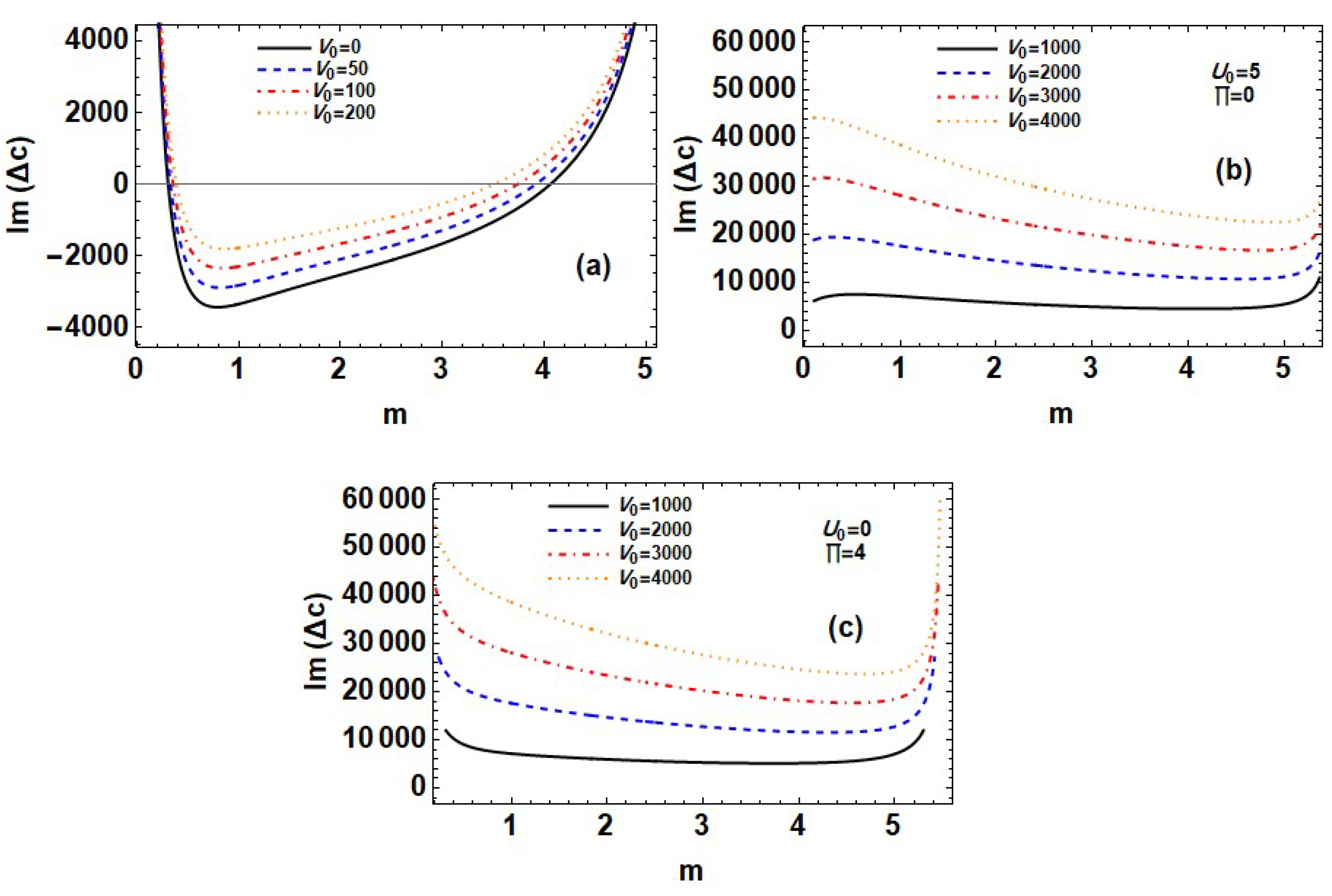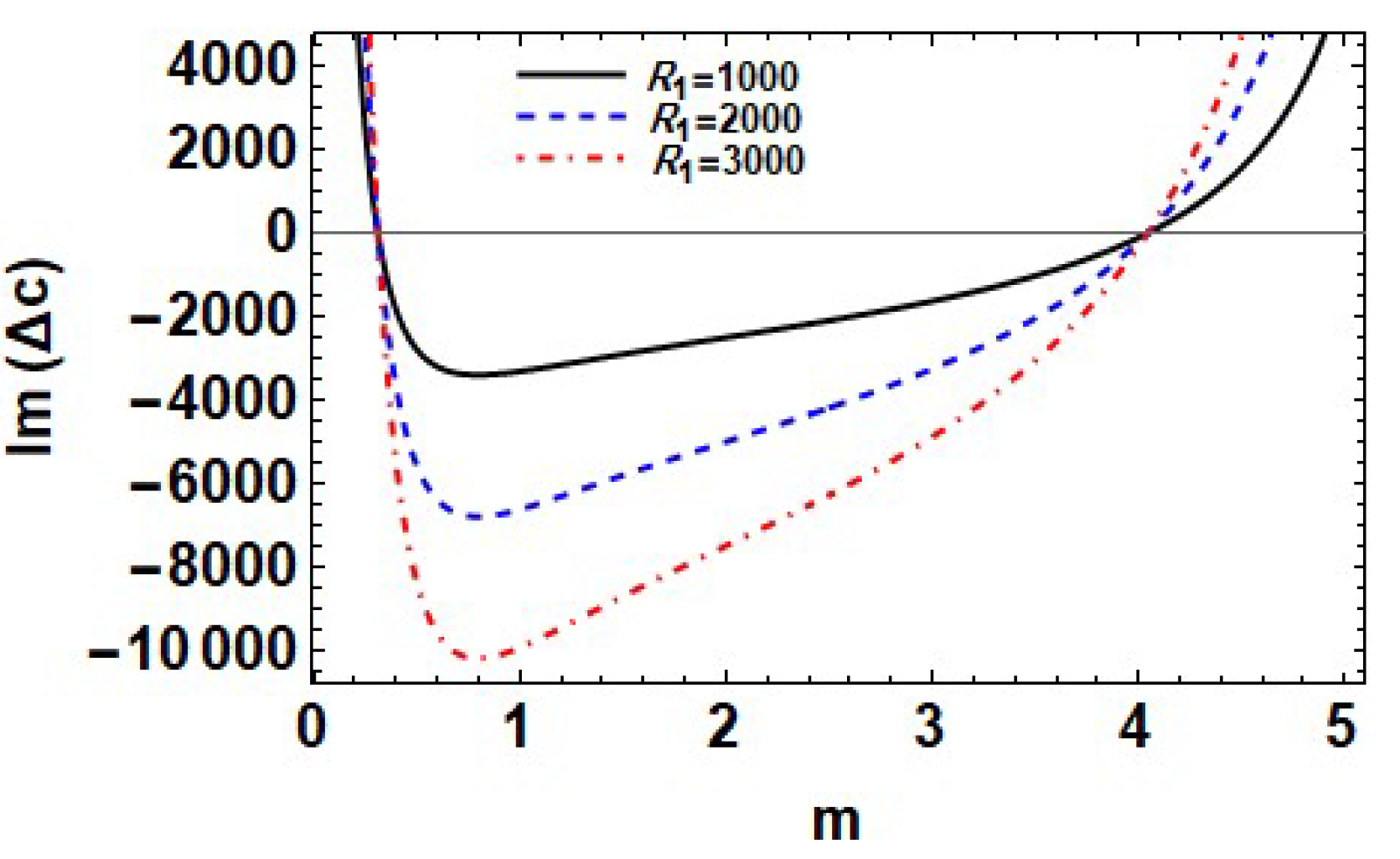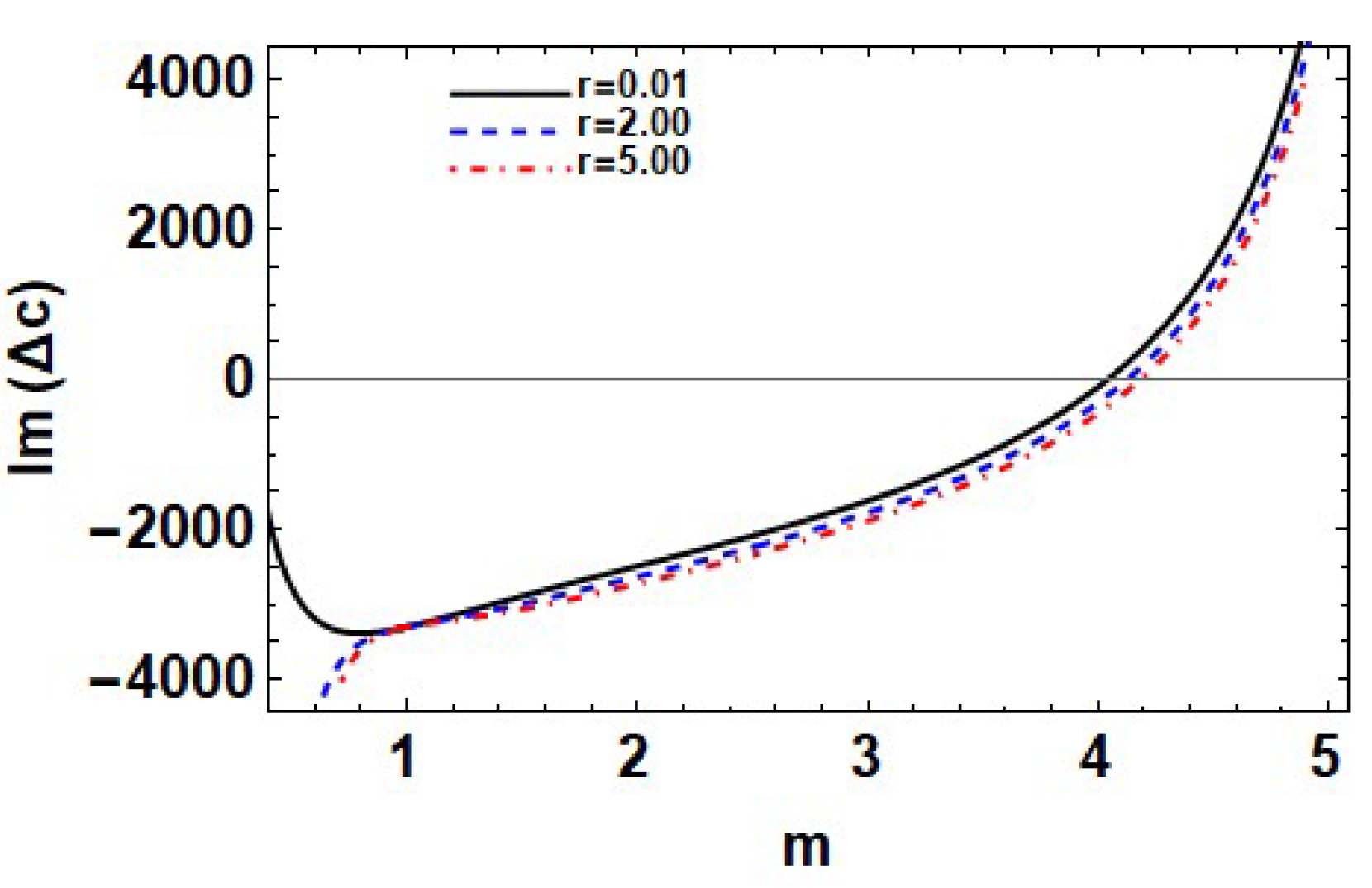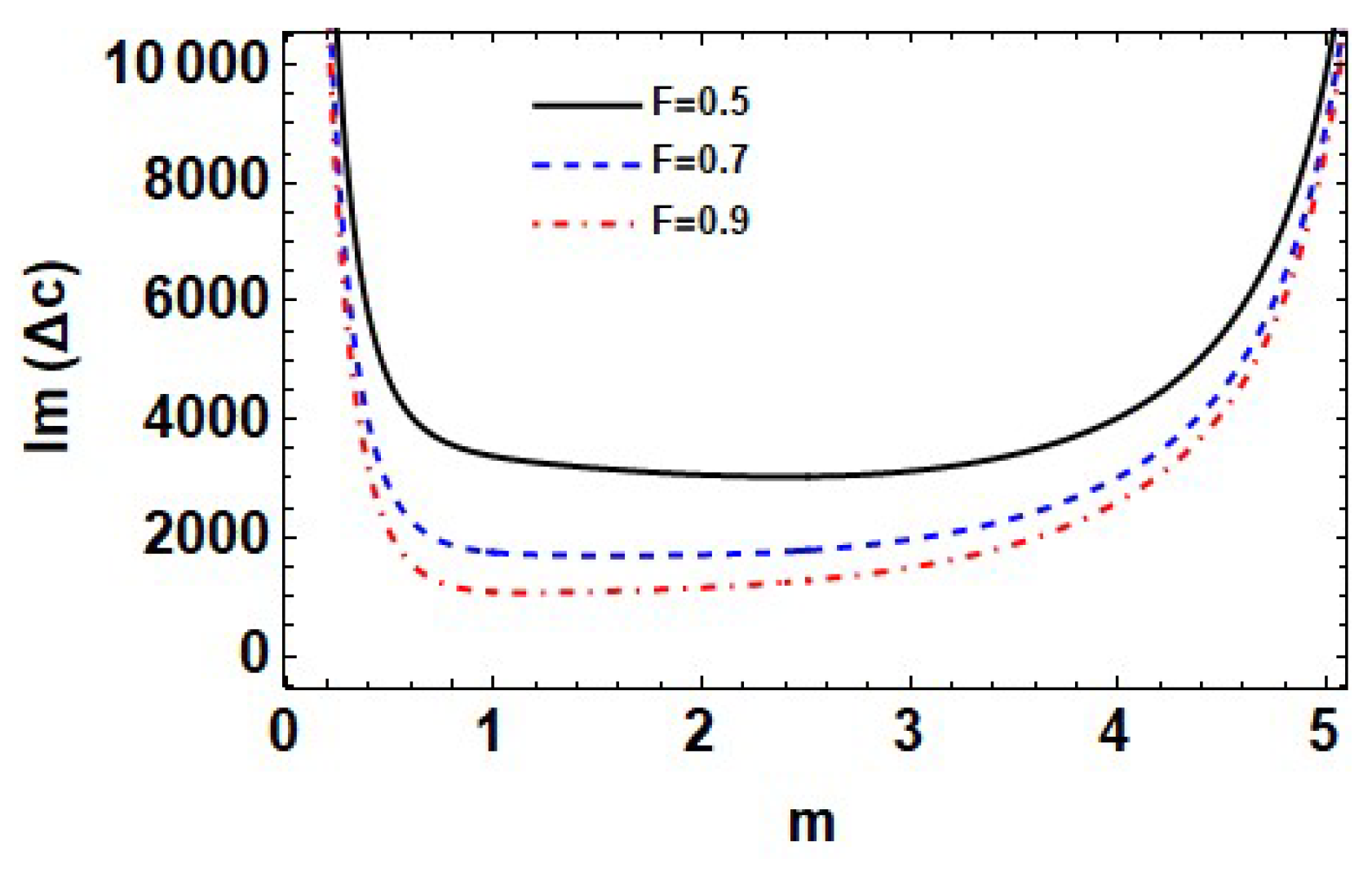Electrohydrodynamic Couette–Poiseuille Flow Instability of Two Viscous Conducting and Dielectric Fluid Layers Streaming through Brinkman Porous Medium
Abstract
:1. Introduction
2. Mathematical Model and Dimensionless Equations
3. Primary Flow and Linearized Model Equations
4. Derivations of Orr–Sommerfeld Equations
5. Boundary and Interfacial Conditions
- (1)
- The two rigid boundaries’ no-slip boundary condition demands that [4]
- (2)
- At the interface of separation , the continuity of demands that
- (3)
- At the interface, the linearized kinematic boundary requirements are met, i.e.,
- (4)
- (5)
- It is clear from Equation (11) that the electric field is an irrotational vector, and therefore, there exists an electric potential , such that [10]From Equation (48), and using the initial conditions that , and , where is the dimensionless electric potential on the rigid boundary , we obtainand from Equations (10) and (48), we obtainThe solution of the electric potential (51) must the boundary condition that vanishes at the lower rigid boundary , and also as the potential should disappear at the disturbed interface , then utilizing Taylor’s expansion at the equilibrium interface , we obtainThen, the perturbed electric potential (51) can be written in the form
- (6)
- The stress tensor’s tangential component is continuous across the interface , then for the first-order terms, we obtain [25]
- (7)
- Across the interface , the normal component of the stress tensor is discontinuous by the surface tension T; then, for the first-order terms, we obtain [10]whereAlso, we can write
6. Solution of the Eigenvalue Problem for Long Waves
6.1. First-Order Approximation
6.2. Second-Order Approximation
7. Dispersion Relation and Stability Analysis
7.1. Effect of Velocity of Upper Rigid Boundary
7.2. Effect of Electric Potential Function
7.3. Effect of Reynolds Number
7.4. Effect of Medium Permeability
7.5. Effect of Porosity of Porous Medium
7.6. Effect of Dielectric Constant
7.7. Effect of Upper to Lower Depth Ratio n
7.8. Effect of Upper to Lower Density Ratio r
7.9. Effect of Pressure Gradient
7.10. Effect of Froude Number F
8. Concluding Remarks
- (1)
- Critical values of the viscosity ratio distinguish the stabilizing and destabilizing effects of the velocity of the upper rigid boundary and Reynolds number on the stability of the system.
- (2)
- In the Couette–Poiseuille flow situation, the electric potential has a destabilizing effect on the system under consideration. As a result, the system is destabilizing in the presence of the electric field even if it is both stable and unstable when the electric field is absent. The electric potential has a destabilizing influence on the system for both the plane Couette flow and the plane Poiseuille flow cases, making the system for the plane Poiseuille flow case more unstable than in the plane Couette flow example.
- (3)
- The system is more unstable when a porous media and/or electric field are absent than when they are present.
- (4)
- For all values of the viscosity ratio m, the system is destabilized by the medium permeability of the porous medium except in the small range , where it has a stabilizing influence.
- (5)
- The examined system is stabilized by the porosity of the porous medium, and for various degrees of porosity, the related curves almost coincide at the same value of viscosity ratio .
- (6)
- The considered system is made unstable by the effects of the dielectric constant and pressure gradient, and the system for dielectric constant values is more unstable than for dielectric constant values .
- (7)
- Depending on the range of viscosity ratios, the upper to lower depth ratio plays a dual role in the stability of the system under consideration, stabilizing as well as destabilizing, while it has a stabilizing influence on the system for .
- (8)
- Since the stability ranges widen by raising their values, whatever they are, the upper to lower density ratio and Froude number have stabilizing effects on this system.
- (9)
- For each of the effects of velocity of the upper rigid boundary, porosity of porous medium, and upper to lower density ratio, the system with fluids of equal dynamic viscosities is found to be neutrally stable.
- (10)
- The viscosity stratification brings about a stabilizing as well as a destabilizing effect on the flow system.
Author Contributions
Funding
Data Availability Statement
Acknowledgments
Conflicts of Interest
Appendix A
References
- Joseph, D.D.; Renardy, Y.Y. Fundamentals of Two-Fluid Dynamics; Part I: Mathematical Theory and Applications; Springer: New York, NY, USA, 1993. [Google Scholar]
- Yih, C.-S. Instability of liquid flow down an inclined plane. Phys. Fluids 1963, 6, 321–334. [Google Scholar] [CrossRef] [Green Version]
- Smith, M.K. The long-wave interfacial instability of two liquid layers stratified by thermal conductivity in an inclined channel. Phys. Fluids 1995, 7, 3000–3012. [Google Scholar] [CrossRef]
- Yih, C.-C. Instability due to viscosity stratification. J. Fluid Mech. 1967, 27, 337–352. [Google Scholar] [CrossRef]
- Shlang, T.; Sivashinsky, G.I.; Bahchin, A.J.; Frenkel, A.I. Irregular wavy flow due to viscosity stratification. J. Phys. 1985, 46, 863–866. [Google Scholar] [CrossRef]
- Hooper, A.P. Long-wave instability at the interface between two viscous fluids: Thin layer effect. Phys. Fluids 1985, 28, 1613–1618. [Google Scholar] [CrossRef]
- Charru, F.; Fabre, J. Long waves at the interface between two viscous fluids. Phys. Fluids 1994, 6, 1223–1235. [Google Scholar] [CrossRef]
- Tilley, B.S.; Davies, S.H.; Bankoff, S.G. Linear stability theory of two-layer fluid flow in an inclined channel. Phys. Fluids 1994, 6, 3906–3922. [Google Scholar] [CrossRef]
- Merkt, D.; Pototsky, A.; Bestehon, M.; Thiele, U. Long-wave theory of bounded two-layer films with a free liquid-liquid interface: Short- and long-time evolution. Phys. Fluids 2005, 17, 064104. [Google Scholar] [CrossRef] [Green Version]
- Mohamed, A.A.; Elshehawey, E.F.; El-Sayed, M.F. Electrohydrodynamic stability of two superposed viscous fluids. J. Colloid Interface Sci. 1995, 109, 65–78. [Google Scholar] [CrossRef]
- El-Sayed, M.F.; Moatimid, G.M.; Metwaly, T.M.N. Nonlinear electrohydrodynamic stability of two superposed streaming finite dielectric fluids in porous medium with interfacial surface charges. Transp. Porous Med. 2011, 86, 559–578. [Google Scholar] [CrossRef]
- El-Sayed, M.F.; Moussa, M.H.M.; Hassan, A.A.A.; Hafez, N.M. Electrohydrodynamic instability of plane Couette-Poiseuille flow of three superposed viscous stratified dielectric fluid layers. Int. J. Appl. Math. Mech. 2013, 9, 13–50. [Google Scholar]
- Kao, T.W.; Park, C. Experimental investigations of stability of the channel flows. Part 2. Two layered Co-current flow in a rectangular channel. J. Fluid Mech. 1972, 52, 401–423. [Google Scholar] [CrossRef]
- Yiantsios, S.G.; Higgins, B.G. Linear stability of plane Poiseuille flow of two superposed fluids. Phys. Fluids 1988, 31, 3225–3238, Erratum in Phys. Fluids A 1989, 1, 897. [Google Scholar] [CrossRef]
- Sadoghi, V.M.; Higgins, B.G. Stability of sliding Couette-Poiseuille flow in an annulus subject to axisymmetric and asymmetric disturbances. Phys. Fluids A 1991, 3, 2092–2104. [Google Scholar] [CrossRef]
- Hooper, A.P. The stability of two superposed viscous fluids in a channel. Phys. Fluids A 1989, 1, 1133–1142. [Google Scholar] [CrossRef]
- South, M.J.; Hooper, A.P. Linear growth in two-fluid plane Poiseuille flow. J. Fluid Mech. 1999, 381, 121–139. [Google Scholar] [CrossRef]
- You, X.Y.; Zhang, X.; Chen, X. On linear stability of plane Poiseuille flow of two viscosity-stratified liquids. J. Taiwan Univ. 2005, 38, 1017–1020. [Google Scholar]
- Chokshi, P.; Gupta, S.; Yadav, S.; Agrawal, A. Interfacial instability in two-layer Couette-Poiseuille flow of viscoelastic fluids. J. Non-Newton. Fluid Mech. 2015, 224, 17–29. [Google Scholar] [CrossRef]
- Chattopadhyay, G.; Usha, R. On the Yih-Marangoni instability of two-phase Poiseuille flow in a hydrophobic channel. Chem. Eng. Sci. 2016, 145, 214–232. [Google Scholar] [CrossRef]
- Ghosh, S.; Behera, H. Instability mechanism for miscible two-fluid channel flow with wall slip. Z. Angew. Math. Mech. 2018, 98, 1947–1958. [Google Scholar] [CrossRef]
- Chattopadhyay, G.; Ranganathan, U.; Millet, S. Instability in viscosity-stratified two-fluid channel flow over an anisotropic-inhomogeneous porous bottom. Phys. Fluids 2019, 31, 012103. [Google Scholar] [CrossRef]
- Govindarajan, R.; Sahu, K.C. Instabilities in viscosity-stratifed fow. Annu. Rev. Fluid. Mech. 2014, 46, 331–353. [Google Scholar] [CrossRef]
- Melcher, J.R.; Taylor, G.I. Electrohydrodynamics: A review of the role of the interfacial shear stresses. Annu. Rev. Fluid Mech. 1969, 1, 111–146. [Google Scholar] [CrossRef]
- Thaokar, R.M.; Kumaran, V. Electrohydrodynamic instability of the interface between two fluids confined in a channel. Phys. Fluids 2005, 17, 084104. [Google Scholar] [CrossRef]
- Ozen, O.; Aubry, N.; Papageorgiou, D.T.; Petropoulos, P.G. Electrohydrodynamic linear stability of two immiscible fluids in channel flow. Electrochim. Acta 2006, 51, 5316–5323. [Google Scholar] [CrossRef]
- Zahn, J.D.; Reddy, V. Two phase micromixing and analysis using electrohydrodynamic instabilities. Microfluid. Nanofluid. 2006, 2, 399–415. [Google Scholar] [CrossRef]
- Melcher, J.R. Continuum Electromechanics; MIT Press: Cambridge, MA, USA, 1981. [Google Scholar]
- Li, F.; Ozen, O.; Aubry, A.; Papageorgiou, D.T.; Petropoulos, P.G. Linear stability of a two-fluid interface for electrohydrodynamic mixing in a channel. J. Fluid Mech. 2007, 583, 347–377. [Google Scholar] [CrossRef]
- Ersoy, G.; Uguz, A.K. Electro-hydrodynamic instability in a microchannel between a Newtonian and non-Newtonian liquid. Fluid Dyn. Res. 2012, 44, 031406. [Google Scholar] [CrossRef]
- Ozan, S.C.; Uguz, A.K. Nonlinear evolution of the interface between immiscible fluids in a micro channel subjected to an electric field. Eur. Phys. J. Spec. Top. 2017, 226, 1207–1218. [Google Scholar] [CrossRef]
- Kaykanat, S.I.; Uguz, A.K. The linear stability between a Newtonian and a power-law fluid under a normal electric field. J. Non-Newton. Fluid Mech. 2020, 277, 104220. [Google Scholar] [CrossRef]
- Zhang, J.; Zahn, J.D.; Lin, H. A general analysis for the electrohydrodynamic instability of stratified immiscible fluids. J. Fluid Mech. 2011, 681, 293–310. [Google Scholar] [CrossRef]
- Altundemir, S.; Eribol, P.; Uguz, A. Droplet formation and its mechanism in a microchannel in the presence of an electric field. Fluid Dyn. Res. 2018, 50, 051404. [Google Scholar] [CrossRef]
- Papageorgiou, D.T.; Petropoulos, P.G. Generation of interfacial instabilities in charged electrified viscous liquid films. J. Eng. Math. 2004, 50, 223–240. [Google Scholar] [CrossRef]
- Eribol, P.; Uguz, A.K. Experimental investigation of electrohydrodynamic instabilities in micro channels. Eur. Phys. J. Spec. Top. 2015, 224, 425–434. [Google Scholar] [CrossRef]
- Li, H.; Wong, T.N.; Nguyen, N.T. Electrohydrodynamic and shear-stress interfacial instability of two streaming viscous liquid inside a microchannel for tangential electric fields. Micro Nanosyst. 2012, 4, 14–24. [Google Scholar]
- Li, H.; Wong, T.N.; Nguyen, N.T. Instability of pressure driven viscous fluid streams in a microchannel under a normal electric field. Int. J. Heat Mass Transf. 2012, 55, 6994–7004. [Google Scholar] [CrossRef] [Green Version]
- Eribol, P.; Kaykanat, S.I.; Ozan, S.C.; Uguz, A.K. Electrohydrodynamic instability between three immiscible fluids in a microchannel: Lubrication analysis. Micrdfluid. Nanofluid. 2022, 26, 16. [Google Scholar] [CrossRef]
- Bejan, A. Porous and Complex Flow Structure in Modern Technology; Springer: Berlin/Heidelberg, Germany, 2004. [Google Scholar]
- Straughan, B. Stability and Wave Motion in Porous Media; Applied Mathematical Sciences; Springer: New York, NY, USA, 2008. [Google Scholar]
- Nield, D.A.; Bejan, A. Convection in Porous Medium, 4th ed.; Springer: New York, NY, USA, 2013. [Google Scholar]
- Allen, M.B., III; Behie, G.A.; Trangenstein, J.A. Multiphase Flow in Porous Media: Mechanics, Mathematics, and Numerics; Springer: New York, NY, USA, 2013. [Google Scholar]
- Del Rio, J.A.; Whitaker, S. Electrohydrodynamics in Porous Media. Tranp. Porous Med. 2001, 44, 385–405. [Google Scholar] [CrossRef]
- Liu, R.; Liu, Q.S.; Zhao, S.C. Instability of plane Poiseuille flow in a fluid-porous system. Phys. Fluids 2008, 20, 104105. [Google Scholar] [CrossRef] [Green Version]
- El-Sayed, M.F. Electrohydrodynamic instability of two superposed viscous streaming fluids through porous media. Can. J. Phys. 1997, 75, 499–508. [Google Scholar] [CrossRef]
- Eldabe, N.T. Electrohydrodynamic stability of two stratified power law liquids in couette fow. Nuovo C. B 1988, 101, 221–235. [Google Scholar] [CrossRef]
- Goyal, H.; Kumar, A.A.P.; Bandyopadhay, D.; Usha, R.; Banerjee, T. Instability of confined two-layer flow on a porous medium: An Orr-Sommerfeld analysis. Chem. Eng. Sci. 2013, 97, 109–125. [Google Scholar] [CrossRef]
- Chimetta, B.R.; Franklin, E.M. Asymptotic and numerical solutions of the Orr-Sommerfeld equation for a thin liquid film on an inclined plane. In Proceedings of the IV Journeys in Multiphase Flows (JEM2017), Sao Paulo, Brazil, 27–31 March 2017. [Google Scholar]
- Ramakrishnan, V.; Mushthaq, R.; Roy, A.; Vengadesan, S. Stability of two-layer flows past slippery surfaces. I. Horizontal channels. Phys. Fluids 2021, 33, 084112. [Google Scholar] [CrossRef]
- Zakhvataef, V.E. Longwave instability of two-layer dielectric fluid flows in a transverse electrostatic field. Fluid Dyn. 2000, 35, 191–199. [Google Scholar] [CrossRef]
- Zakaria, K.; Alkharashi, S.A. Modeling and analysis of two electrified films flow traveling down between inclined permeable parallel substrates. Acta Mech. 2017, 228, 2555–2581. [Google Scholar] [CrossRef]
- El-Sayed, M.F. Nonlinear analysis and solitary waves for two superposed streaming electrified fluids of uniform depths with rigid boundaries. Arch. Appl. Mech. 2008, 78, 663–685. [Google Scholar] [CrossRef]
- El-Sayed, M.F. Instability of two streaming conducting and dielectric bounded fluids in porous medium under time-varying electric field. Arch. Appl. Mech. 2009, 79, 19–39. [Google Scholar] [CrossRef]
- Hussain, Z.; Khan, N.; Gul, T.; Ali, M.; Shahzad, M.; Sultan, F. Instability of magnetohydrodynamic Couette flow for electrically conducting fluid through porous media. Appl. Nanosci. 2020, 10, 5125–5134. [Google Scholar] [CrossRef]











Disclaimer/Publisher’s Note: The statements, opinions and data contained in all publications are solely those of the individual author(s) and contributor(s) and not of MDPI and/or the editor(s). MDPI and/or the editor(s) disclaim responsibility for any injury to people or property resulting from any ideas, methods, instructions or products referred to in the content. |
© 2023 by the authors. Licensee MDPI, Basel, Switzerland. This article is an open access article distributed under the terms and conditions of the Creative Commons Attribution (CC BY) license (https://creativecommons.org/licenses/by/4.0/).
Share and Cite
El-Sayed, M.F.; Amer, M.F.E.; Alfayzi, Z.S. Electrohydrodynamic Couette–Poiseuille Flow Instability of Two Viscous Conducting and Dielectric Fluid Layers Streaming through Brinkman Porous Medium. Mathematics 2023, 11, 3281. https://doi.org/10.3390/math11153281
El-Sayed MF, Amer MFE, Alfayzi ZS. Electrohydrodynamic Couette–Poiseuille Flow Instability of Two Viscous Conducting and Dielectric Fluid Layers Streaming through Brinkman Porous Medium. Mathematics. 2023; 11(15):3281. https://doi.org/10.3390/math11153281
Chicago/Turabian StyleEl-Sayed, Mohamed F., Mohamed F. E. Amer, and Zakaria S. Alfayzi. 2023. "Electrohydrodynamic Couette–Poiseuille Flow Instability of Two Viscous Conducting and Dielectric Fluid Layers Streaming through Brinkman Porous Medium" Mathematics 11, no. 15: 3281. https://doi.org/10.3390/math11153281
APA StyleEl-Sayed, M. F., Amer, M. F. E., & Alfayzi, Z. S. (2023). Electrohydrodynamic Couette–Poiseuille Flow Instability of Two Viscous Conducting and Dielectric Fluid Layers Streaming through Brinkman Porous Medium. Mathematics, 11(15), 3281. https://doi.org/10.3390/math11153281





